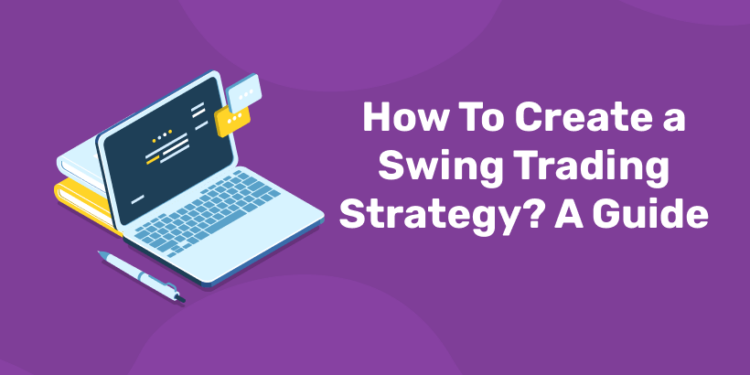Table of Contents
Swing trading has been gaining popularity as people look for ways to bring in extra income while working their full time job. And with the arrival of sophisticated apps, trading while on the go has never been easier.
What is Swing Trading?
Swing trading is a trading style that involves holding on to a position for a period of time ranging from a couple days to a couple weeks.
Enroll for Stock Marketing Course! Download Entri App!
It’s an active trading strategy that captures the swings in market sentiment and allows you to enter and exit at key levels. Swing trading differs from day trading in that you are likely to hold your positions overnight. Your trades might last several days or even weeks.
Swing trading strategies are generally driven by technical analysis. You can employ your strategy in trending markets as well as in choppy market conditions.
Your focus should be a short time horizon when you determine your swing trading risk and reward. Before you determine if swing trading is right for you, consider the several pros and cons of swing trading relative to day trading.
Pros
- You need to devote less time to swing trading.
- It captures most of the upward and downward swings in price action.
- You can focus on technical analysis.
Cons
- You increase your risk by holding positions for longer periods.
- You could face sharp market reversals that generate losses.
- You can not take advantage of day trading leverage.
Swing Trading Basics: How Swing Trading Works
1: What is a stock?
Swing trading involves identifying profitable times to enter trades based on two different types of swing: ‘swing lows’ and ‘swing highs’. A swing low is a term used to refer to a major price low, while a swing high is a term used to highlight a major price high.
A swing trader is concerned with trying to capture the price movements between these major lows and highs. In an uptrend, a trader would be looking to buy, or ‘go long’, from these lows and close the trade at the swing highs. In a downtrend, traders would be looking to sell, or ‘go short’, from the highs to the lows.
It is impossible to consistently pinpoint the exact high and low of every swing move, but the idea is to capture as much of the price movement as possible. In fact, it’s common to miss the exact highs and lows, as it can take time to confirm that a new swing is underway.
Start Your Stock Market Journey Today!
Learn practical strategies, minimize risks, and grow your wealth confidently. Enroll now and take your first step toward financial success!
Know moreTwo Popular Swing Trading Strategies
We’ve summarised two popular swing trading strategies that are used to create a methodology for entering and exiting a market. These are:
- Trend trading
- Breakout trading
Enroll for Stock Marketing Course! Download Entri App!
Trend Trading
A trend trading strategy relies on using technical indicators to identify the direction of market momentum. Swing trading strategies will look to capture a portion of this trend, taking advantage of the swing high or low.
Trend traders will take a long position if they believe the market is going to reach higher highs, and a short position if they think the market will reach lower lows. They would then exit the trade when analysis indicated a reversal was imminent.
Some of the most popular technical analysis tools used in trend-following strategies include moving averages, the relative strength index (RSI) and the average directional index (ADX).
Breakout Trading
Breakout trading is the strategy of taking a position as early as possible within a given trend, in order to capitalise on the market movement. Swing traders will look to identify points at which the market is about to ‘break out’ from the range in which it has been trading – typically when a support or resistance line is broken.
Breakout trading requires the trader to know how strong or weak the market momentum is, which is usually calculated using the volume of trades that are taking place. This is why volume-weighted moving averages are a popular technical analysis tool among swing traders.
What Are the Advantages of a Simple Swing Trading Strategy?
The main advantage of swing trading is that it offers great risk to reward trading opportunities. In other words, you’re going to risk a smaller amount of your account balance for a potentially much bigger profit, compared to your risk.
The second benefit of using swing trading strategies that work is that they eliminate a lot of intraday noise. Now you’ll be trading like the smart money does, which is in the big swing waves.
The third benefit of swing trading relies on the use of technical indicators. Using technical indicators can reduce the risks of speculative trading and help you to make clear decisions. While some swing traders pay attention to fundamental indicators as well, they are not needed for our simple strategies.
The last benefit of using a simple swing trading strategy is that you won’t need to be glued to the screen for the whole day like with day trading strategies. A swing trading plan will work in all markets starting from stocks, commodities, Forex currencies, and much more.
Like any trading strategy, swing trading also has a few risks. Because swing trading strategies take several days or even weeks to play out, you face the risks of “gaps” in trading overnight or over the weekend.
Another risk of swing trading is that sudden reversals can create losing positions. Because you are not trading all throughout the day, it can be easy to be caught off guard if price trends do not play out as planned. To decrease the risk of this happening, we recommend issuing stop orders with every new position. Stop orders can help you “lock in” your gains and can also help you cut your losses.
Swing Trading Strategy That Works
This strategy is really only made of two elements. The first element of any swing strategy that works is an entry filter. For our entry filter, we’re going to use one of our favorite swing trading indicators aka the Bollinger Bands. The second element is a price action based method.
Step #1: Wait for the price to touch the upper Bollinger Band.
The first element we want to see for our simple trading strategy is that we need to see the stock price moving into overbought territory. Any swing trading strategy that works should have this element incorporated.
Step #2: Wait for the price to Break below the Middle Bollinger Bands.
After we have touched the upper Bollinger Band, we want to see confirmation that we are in overbought territory and the market is about to reverse. The logical filter, in this case, is to look after a break below the middle Bollinger Band.
The break below the middle Bollinger Bands is a clear signal of the shift in market sentiment.
We at Trading Strategy Guides don’t trade breakouts without determining whether or not there are real buyers/sellers (in our case, sellers) behind the breakout. This brings us to the next step of our simple swing trading strategy.
Step #3: Swing Trading Indicator: The Breakout Candle needs to be a Big Bold candle that closes near the Low Range of the Candlestick. → Sell at the Close of the Breakout Candle.
So far our favorite swing trading indicator has correctly predicted this sell-off, but we’re going to use a very simple candlestick-based method for our entry trigger. For entry, we want to see a big bold bearish candle that breaks below the middle Bollinger Band.
The second element of this candlestick-based method is that we need the breakout candle to close near the low range of the candlestick. This is indicative of strong sellers, which really want to drive this currency pair much lower.
Every swing strategy that works needs to have quite simple entry filters.
Now, we still need to define where to place our protective stop loss and where to take profits, which brings us to the next step of our simple swing trading strategy.
Step #4: We hide our Protective Stop Loss above the Breakout Candle.
The breakout candle has a lot of significance because we’ve used it in our candlestick based entry method. We assumed that this candle shows the presence of real sellers in the market. If the high of this candle were to be broken, it’s clear enough that this is simply a fake breakout as there are no real sellers.
Step #5: Take Profit once we break and close back above the middle Bollinger Bands.
In this particular case, we’re looking at a short trading example. So, if the price breaks back above the middle Bollinger Banks it’s time to get worried and take our profits as it can signal a reversal.
The reason why we take profit here is quite easy to understand. We want to book the profits at the early sign the market is ready to roll over.
Enroll for Stock Marketing Course! Download Entri App!
Popular Swing Trading Indicators
In order to create a swing trading strategy, many traders will use price charts and technical indicators to identify potential swings in a market, and profitable entry and exit points. Popular swing trading indicators include:
- Moving averages
- Relative strength index
- Stochastic oscillator
Moving Averages
One of the most popular indicators to use is the moving average (MA). This indicator looks at the closing price data over a period of time, to ascertain the average value of the asset. For example, using a 50-day MA would take the closing price for each of the last 50 days, add them up, and divide them by 50 to get the average price. These points are then plotted together to create a single line, smoothing out the market movements, so that a trader can better understand the overall trend.
The MA is focused on identifying or confirming a trend, rather than predicting it – this is because the MA is a lagging indicator, so it will always be slightly behind the market price. In principle, when the price is trading firmly above the moving average the trend is considered to be up and when the price is trading below the moving average the trend is considered to be down.
A common moving average strategy is to look for crossovers between two exponential moving averages, which give a greater weighting to more recent price data – unlike a standard MA. Normally, this strategy uses one fast exponential moving average (EMA) such as the 50-day EMA in the chart below (the red line) and one slow EMA such as the 100-day EMA below (the green line). The aim is to look for points at which moving averages cross paths, which can signal a change in the price direction. If the fast EMA crosses the slow EMA from below, a swing trader might consider opening a long position, while they would enter into a short position when the fast EMA crosses the slow EMA from above.
Relative Strength Index (RSI)
Once a trend is identified, a trader could consider using a momentum indicator to try to capture swings in the overall trend. A popular momentum indicator is the RSI, which swing traders can use to judge whether a market is overbought or oversold – meaning the market could be reaching a ‘swing’.
The RSI is classified as an oscillator, as it is represented on a chart from zero to 100. Typically, anything above 70 is thought of as overbought. And if the price falls below the level 30, it is considered oversold.
In an uptrend, a move out of oversold territory as indicated by the RSI might be a signal to buy a trade. An overbought signal may be a signal to exit the trade. In a downtrend, a move out of overbought territory might be a signal to enter a short trade, while an oversold signal may be a signal to exit the short trade and not trade against the trend.
Stochastic Oscillator
Similar to the RSI, the stochastic oscillator is a momentum indicator. It compares the most recent closing price to the previous trading range for a given period – usually 14 days. The theory behind the stochastic is that market momentum changes ahead of market volume or the price itself, making it a leading indicator. So, by trading based on momentum, a trader can attempt to predict the swings.
Enroll for Stock Marketing Course! Download Entri App!
The stochastic is presented as two lines – the indicator line (the black line on the below chart) and the signal line (the red dotted line below). These lines oscillate on a scale between zero to 100. If there is a reading over 80, the market would be considered overbought, while a reading under 20 would be considered oversold conditions.
If the two lines cross, it is often a sign that a change in market direction is approaching. If the indicator line rises above the signal line, swing traders might consider opening a long position – unless the values are above 80. And if the indicator line falls lower than the signal line, swing traders might consider opening a short position – unless the values are below 20.













